ASRock A75 Extreme6 Review and Desktop Llano Overclocking
by Ian Cutress on June 30, 2011 12:05 AM ESTLAN Speed Test
LAN Speed Test is a freeware program designed for testing the network connection between two PCs on a home network. The speed of the transfer is limited by the lowest common denominator on the network, so if you have gigabit Ethernet capable computers but a 100 Mbit capable router, you are limited to 100 Mbit transfer. Note that this is really a formality – if a network port is rated at 1 Gbps, then chances are that it will hit at least 90+% of this value. The main test here is CPU usage, and how much is offloaded by the controller. For this test, we use LAN Speed Test to transfer a 1000 MB file across a home network with a 100 Mbps lowest common speed to the same machine each time, in a read/write scenario. CPU usage is taken as a visual max/average from task manager.

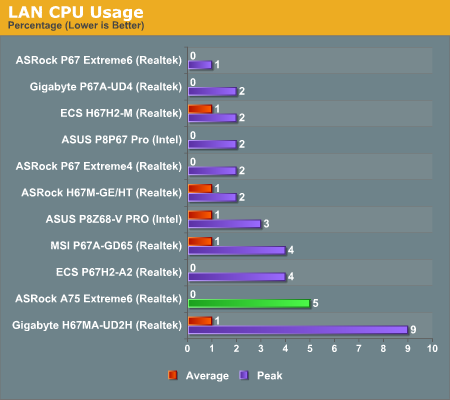
USB Speed
For this benchmark, we run CrystalDiskMark to determine the ideal sequential read and write speeds for the USB port using our 64GB Patriot SuperSpeed USB 3.0 drive. Then we transfer a set size of files from the SSD to the USB drive, and monitor the time taken to transfer. The files transferred are a 1.52 GB set of 2867 files across 320 folders – 95% of these files are small typical website files, and the rest (90% of the size) are the videos used in the Sorenson Squeeze test.
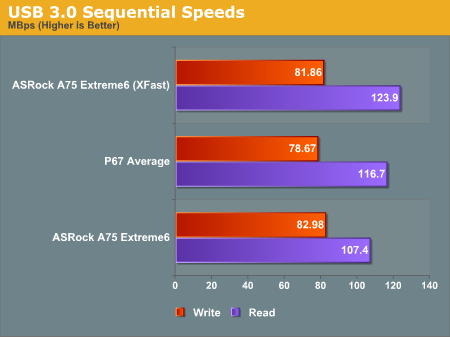
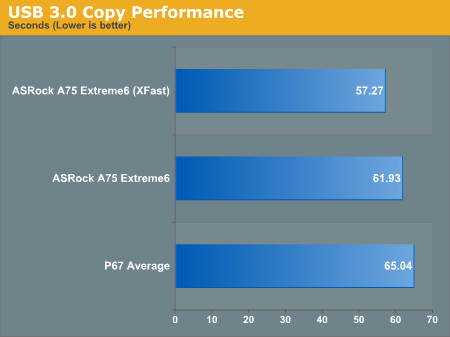
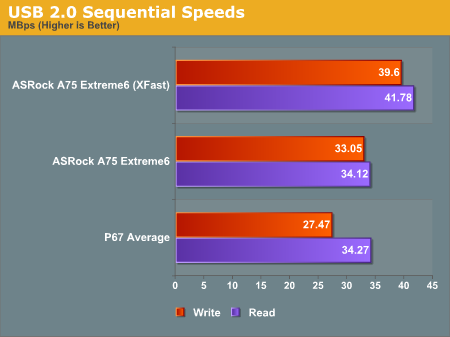
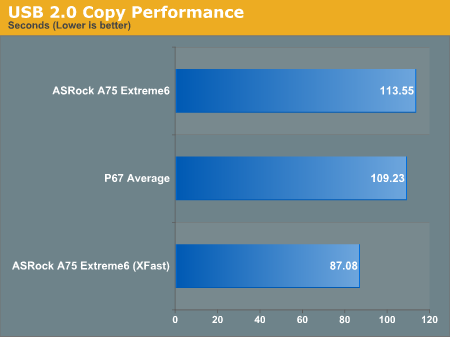
SATA Testing
We also use CrystalDiskMark for SATA port testing. The operating system is installed on the Micron RealSSD C300, which is rated at 355 MB/s read and 215 MB/s write, and the sequential test is run at the 5 x 1000 MB level. This test probes the efficiency of the data delivery system between the chipset and the drive, or in the case of additional SATA ports provided by a third party controller, the efficiency between the controller, the chipset and the drive.
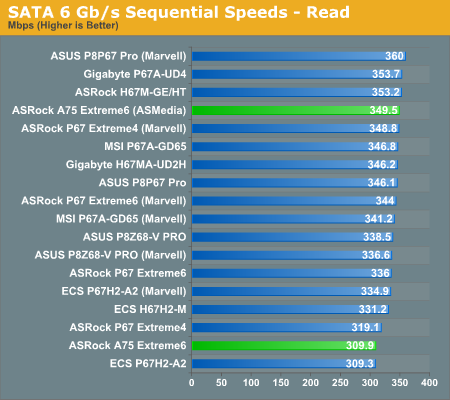

DPC Latency
Deferred Procedure Call latency is a way in which Windows handles interrupt servicing. In order to wait for a processor to acknowledge the request, the system will queue all interrupt requests by priority. Critical interrupts will be handled as soon as possible, whereas lesser priority requests, such as audio, will be further down the line. So if the audio device requires data, it will have to wait until the request is processed before the buffer is filled. If the device drivers of higher priority components in a system are poorly implemented, this can cause delays in request scheduling and process time, resulting in an empty audio buffer – this leads to characteristic audible pauses, pops and clicks. Having a bigger buffer and correctly implemented system drivers obviously helps in this regard. The DPC latency checker measures how much time is processing DPCs from driver invocation – the lower the value will result in better audio transfer at smaller buffer sizes. Results are measured in microseconds and taken as the peak latency while cycling through a series of short HD videos - under 500 ms usually gets the green light, but the lower the better.
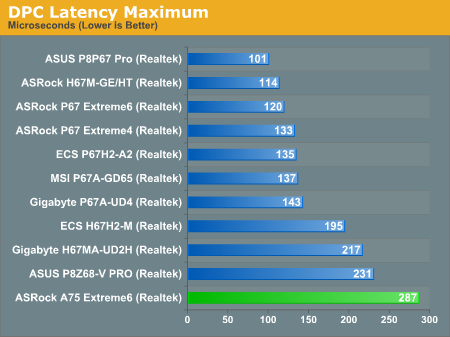










44 Comments
View All Comments
Exodite - Thursday, June 30, 2011 - link
I'd agree that no common task /requires/ an i3 2100, or a Llano equivalent, but between the two of them the former is the better option for such.Most significantly Llano /doesn't/ have a much better graphics solution. Sure, it's better but still not good enough to do native resolution gaming and low/mid settings - which is the bare minimum for gaming at this day and age.
For anything else, speaking about the GPU-side of things, anything will suffice. Certainly both Llano and Intel's HD2000/HD3000 solutions.
Perhaps I were overly enthusiastic about Llano's GPU prowess, I didn't expect it to be quite as memory-starved as it was, but I always envisoned it being a lot closer to what a discrete solution with the same clocks and core count would offer.
As it is I'd recommend an Intel solution to anyone at this point, with or without a discrete card as required.
You may chose to scream bloody murder about it if you want to, it's no skin of my back, but the numbers do speak for themselves.
mino - Thursday, June 30, 2011 - link
"I'd agree that no common task /requires/ an i3 2100, or a Llano equivalent, but between the two of them the former is the better option for such."Yeah, between the two i3 is a better option for uncommon single-threaded tasks.
Now, what have those to do with the low-end desktop market?
L. - Thursday, June 30, 2011 - link
Bloody Murder !No shit ... "doesn' t have a much better graphics solution" ...
Seriously read a few other reviews and you'll understand there is a world of difference between 11 fps and 30, dx11 and no dx11, etc.
There are MANY games which lie on the fringe of "playable" with a Llano which are clearly unplayable on an i3.
The fact that this review is not showing is that with all those, the difference is between play and no play, and everytime the Llano is far ahead.
I linked a review in the comments of the OC article here on AT and it shows things ... like 11 fps crysis gamer settings @ 1920x1080.
While 11fps is not playable, 11fps in crysis w/ those settings and that resolution implies almost everything is playable with some stuff tuned down.
THIS IS NOT THE CASE with an i3.
The difference might be hidden w/ these benchmarks but it's there and so big it cannot justify the pricing of the i3 2105.
Llano is good enough to do native resolution gaming @ low / mid settings, even if you consider native to be full HD, there are many many many games that are playable on it this way.
http://www.xbitlabs.com/articles/cpu/display/amd-a...
Yet another one ... high quality, full HD, far cry 2 , playable on Llano, 11 fps on HD3000.
Finally - Thursday, June 30, 2011 - link
A German magazine has proven that a Llano will run fine with DDR3-1600 (and upwards). It's called computerbase, have a look: http://tinyurl.com/6zsv6kkFinally - Thursday, June 30, 2011 - link
DDR3-1600 RAM isn't that much more expensive than the run-of-the-mill type... both are ridiculously cheap right now.With only 65€ for 8GB of (good gamer) RAM, I'd say that this has already become the new standard minimum amount.
havoti97 - Sunday, July 3, 2011 - link
You are not entitled to anything. You get what's given to you. If you don't like it, go look elsewhere or do yar own benchmark.L. - Thursday, June 30, 2011 - link
This is almost correct.a) s1155 prices have dropped, you can expect A75 to do the same
b) Llano is AMD and WILL be cheaper
c) The core i3 2100 is way overkill for flash, full hd and basic stuff
d) For that you have a 18W e-350 that's so much more money and power efficient
e) Office desktops do NOT need the power of an i3-2100
Besides, you seem to think the GPU is useless outside of games, might be partly true today but it's not meant to last.
ganteng3005 - Thursday, June 30, 2011 - link
IMHO it's not that GPU is useless outside of games (even Windows Aero requires a "real" GPU to run), but what I'm saying is that Intel HD Graphics is sufficient for daily usage except gaming and graphical computing. I might be incorrect, though, but for me, personally, an i3 2100 is sufficient (even overkill, I agree) for office tasks.E-350 and Pentium G620 (SB) might be better in price/performance, but what I've noticed from the E-350 (and of course, Intel Atom) is the lack of real-time responsiveness on laptops. It might be just me, though.
kevith - Thursday, June 30, 2011 - link
Does that mean to say, that I´ll not be able to run Windows Aero with any buil-in GPU? AMD or Intel...StormyParis - Thursday, June 30, 2011 - link
"Besides, you seem to think the GPU is useless outside of games, might be partly true today but it's not meant to last.".We'll see when we get there. The industry has a terrible, terrible record of adapting software to new hardware, especially to new CPU instruction sets / capabilities. Look at all the x86 extensions that are still barely used (anything after SSE2 ?).
My take it... that exact same quote will still apply 3 yrs from now, and by then, we'll be due for an upgrade ^^